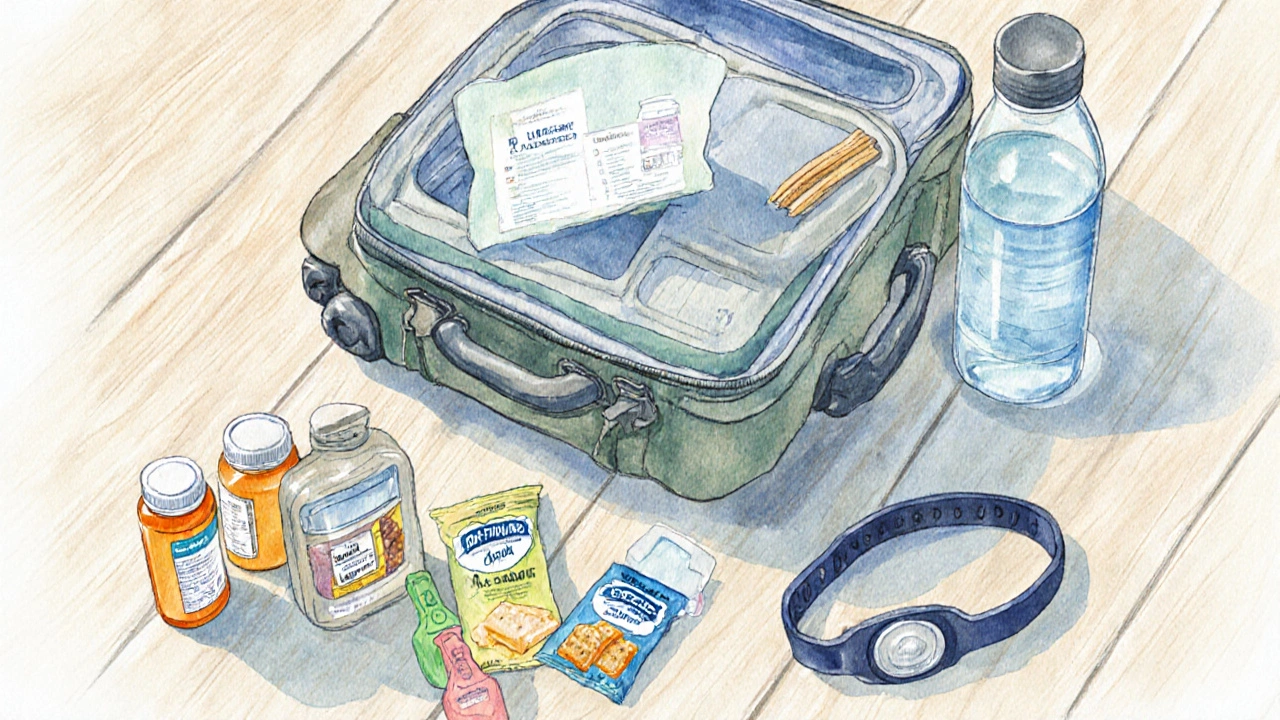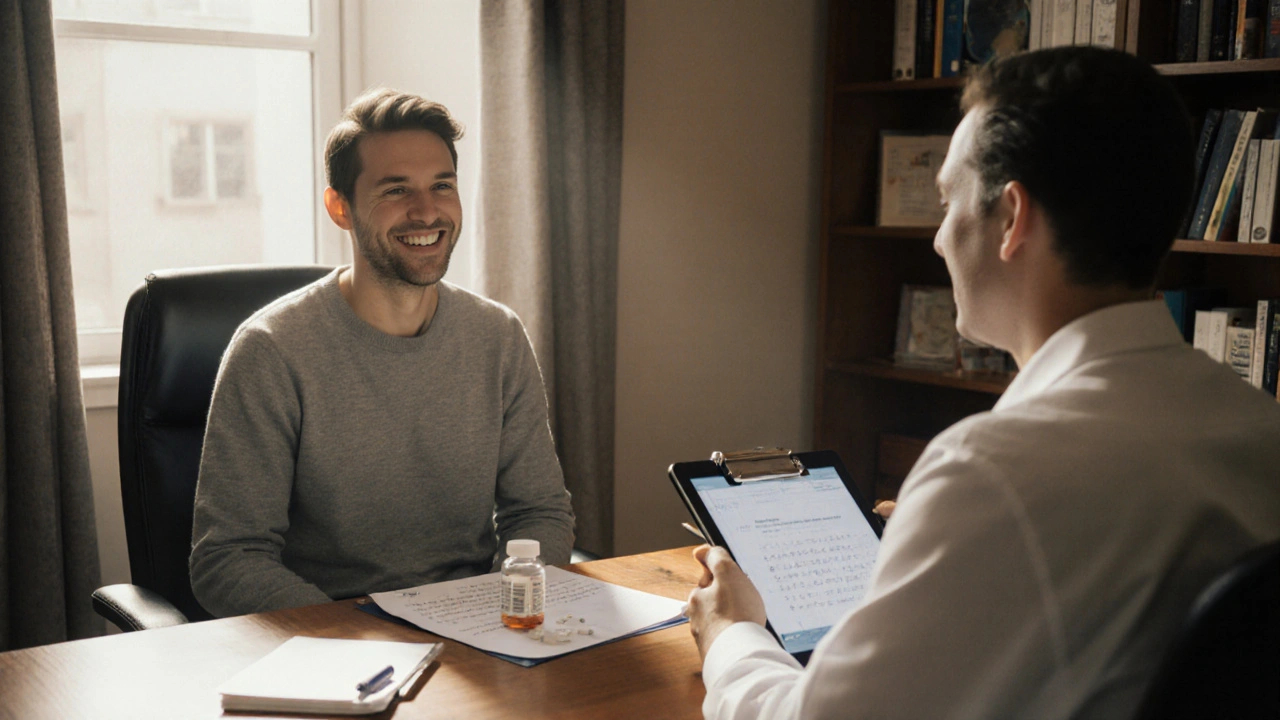Crohn's Disease Travel Planner
Recommended Supply:
Additional Emergency Buffer:
Recommended Plan:
Max Medical Evacuation:
Estimated Cost:
Quick Actions During a Flare-Up:
- Locate nearest restroom
- Take rescue medication as prescribed
- Stay hydrated with clear fluids
- Seek medical attention if symptoms persist beyond 24 hours
Emergency Contact Info:
Keep your doctor's contact info and travel insurance details easily accessible.
Planning a trip while living with Crohn's disease is a chronic inflammatory bowel condition that can cause abdominal pain, diarrhea, and fatigue feels like juggling a suitcase full of worries. The good news? With the right prep, you can still explore new cities, hike scenic trails, and sample local cuisines without constant panic.
Why Pre‑Trip Planning Beats Panic
Most flare‑ups are triggered by stress, dietary changes, or missed doses. By tackling these factors before you board the plane, you turn a potential health crisis into a manageable checklist. Think of it as a travel itinerary for your gut.
1. Talk to Your Gastroenterologist Early
Schedule a visit with your gastroenterologist the specialist who monitors disease activity and adjusts treatment plans at least six weeks before departure. Ask for a written summary of your current regimen, any recent lab results, and a clear plan for dose adjustments if you cross time zones.
2. Get Your Medications in Order
Medication management is the backbone of a safe trip. Here’s how to keep it simple:
- Request a travel letter from your doctor confirming you need the prescribed drugs. This letter should list the generic names, dosages, and why they’re essential.
- Ask for a 30‑day supply plus a 10‑day emergency buffer. Most airlines allow you to carry up to 100ml of liquid medication, but the letter helps if officials question you.
- Consider a portable medication cooler a compact insulated case that keeps temperature‑sensitive drugs like biologics stable for trips to hot climates.

3. Packing Smart: What to Bring
Every item in your bag should have a purpose. Below is a quick reference:
- Original prescription bottles (label intact).
- Travel letter and copies of recent test results.
- A medical alert bracelet wearable jewelry that notifies first responders of your condition (preferably waterproof).
- Low‑FODMAP snack pack: rice cakes, lactose‑free cheese, and a small bottle of electrolyte powder.
- Hydration bottle with a built‑in filter for safe tap water abroad.
- Hand sanitizer and a pack of chlorine wipes for cleaning restaurant tables.
4. Food & Diet on the Road
Changing your diet is the fastest way to trigger a flare. Stick to a low‑FODMAP diet a nutrition plan that limits fermentable carbohydrates known to provoke symptoms as much as possible. Here are practical tips:
- Research restaurants that offer gluten‑free or plain‑protein options before you arrive.
- When ordering, ask for sauces on the side and skip high‑fiber vegetables like broccoli, cabbage, or onions.
- Carry a small notebook of safe foods; many travelers find it easier to point than to explain.
- Stay hydrated-aim for at least 2liters of water daily. In desert climates, add a pinch of salt or an electrolyte tablet to prevent dehydration‑induced cramps.
5. Spotting and Managing a Flare‑Up
If symptoms sneak up, act fast:
- Locate the nearest restroom (Google Maps+"public restroom" works well).
- Take a rescue dose of your prescribed steroid or anti‑diarrheal medication as advised by your doctor.
- Drink clear fluids-broth, herbal tea, or oral rehydration solution.
- If you’re unable to control the flare after 24hours, seek local medical care. Having the travel letter ready cuts down on waiting time.
6. Navigating Healthcare Abroad
Knowing where to get help can turn a scary situation into a routine check‑in.
- Identify hospitals or clinics that have an English‑speaking gastroenterology department.
- Check if your travel insurance policy that covers pre‑existing conditions and emergency medical evacuation pre‑approves treatments for chronic illnesses.
- Download a translation app that includes medical phrases like "I have Crohn's disease" and "I need my medication now".

7. Choosing the Right Travel Insurance
Not all policies treat chronic conditions the same. Below is a quick comparison of three popular plans (prices are averages for a 2‑week trip, 2025 rates):
| Provider | Coverage for Pre‑Existing Conditions | Maximum Medical Evacuation | Cost (USD) |
|---|---|---|---|
| WorldCare Plus | Up to 100% after medical questionnaire | $250,000 | $115 |
| SafeTravel Guard | 80% after 30‑day waiting period | $200,000 | $98 |
| GlobeShield Elite | Full coverage with no waiting period (premium tier) | $300,000 | $165 |
Pick the plan that matches your risk tolerance and budget. Remember to read the fine print about “medical evacuation” - it can mean air‑lifting you to a facility that can handle your specific medication needs.
8. Quick Checklist Before You Go
- Confirm appointments with gastroenterologist; get travel letter.
- Order extra medication (30% buffer) and pack in original bottles.
- Buy a portable medication cooler if traveling to >30°C zones.
- Register with your embassy for emergency contact.
- Download a translation app and store local hospital numbers.
- Set up travel insurance that covers pre‑existing conditions.
- Pack low‑FODMAP snacks, electrolyte powder, and a reusable water bottle.
- Wear a medical alert bracelet and keep a copy of your medical summary in your carry‑on.
Real‑World Story: From Sydney to Tokyo
Emma, a 32‑year‑old teacher from Sydney, spent two weeks in Japan last spring. She followed the steps above: a pre‑trip call with her doctor, a portable cooler for her biologic injection, and a WorldCare Plus policy. On day three, a sudden stomach cramp hit while she was in Shibuya. She located a restroom, took her rescue steroid, and hydrated with a pre‑packed electrolyte sachet. By evening, she felt back to normal and continued her sightseeing. Emma’s experience shows that preparation turns a potential crisis into a minor hiccup.
Frequently Asked Questions
Can I bring my biologic medication on a plane?
Yes. Keep the medication in its original container, carry a doctor’s letter, and store it in a portable cooler if it requires refrigeration. Most airlines allow you to bring it in your carry‑on without limits, as long as you can prove it’s medically necessary.
What if I experience a flare in a country with limited healthcare?
First, use your rescue medication and stay hydrated. If symptoms persist beyond 24hours, locate the nearest international hospital. Your travel insurance should cover a tele‑consult with a specialist who can advise on emergency protocols, and in severe cases, arrange medical evacuation.
Do I need a medical alert bracelet?
A bracelet is a low‑cost, high‑visibility way to alert emergency responders about Crohn's disease, especially if you’re unable to speak. Choose a waterproof model and list any critical medications you take.
How can I keep my diet safe while eating out?
Research menus ahead, request meals without onions, garlic, and high‑fiber sides. Opt for grilled proteins, plain rice, and well‑cooked vegetables that are low in FODMAPs. Carry a snack bar of known safe ingredients for times when options are limited.
Is travel insurance worth the cost for chronic conditions?
Absolutely. Unexpected medical costs abroad can run into thousands of dollars. A policy that covers pre‑existing conditions, evacuation, and emergency medication refill can save both money and stress.
With thoughtful planning, a Crohn's flare doesn’t have to ruin your adventure. The key is treating your condition like any other travel gear: pack it, protect it, and have a backup plan. So go ahead, book that flight, and enjoy the journey-your gut will thank you for the preparation.


Audrin De Waal
October 9, 2025 AT 14:40Yo, think of your gut as the true frontier of your body-if you don’t guard it, it’ll be overrun like a careless border. Packing meds is like bringing ammo; you wouldn’t head into a fight empty‑handed, right? Grab that travel letter, load up a buffer, and march on with confidence. Remember, you’re the captain of this expedition, not some helpless tourist.
parag mandle
October 10, 2025 AT 12:53When you’re gearing up for a cross‑continent trek, the drama isn’t in the scenery, it’s in the paperwork. First, lock down a travel letter from your gastroenterologist-think of it as your passport to the pharmacy abroad. Next, stash a 30‑day supply plus a 10‑day emergency buffer in your carry‑on; airlines love a well‑organized bag. If you’re heading to a scorching climate, a portable cooler becomes your lifesaver, keeping biologics from melting like ice cream on a July sidewalk. Don’t forget to download an offline map of public restrooms; finding a loo in a rush can be a scene straight out of an action flick. Hydration is your sidekick, so pack electrolyte powders that dissolve in a sip. With these steps, the only thing you’ll be fearing is missing the sunset, not a flare‑up.
Shivali Dixit Saxena
October 11, 2025 AT 11:06Pack those original bottles!! Keep the doctor’s letter visible!! Load a portable cooler if it’s hot-no excuses!! Stay ahead, stay strong!!
Sayam Masood
October 12, 2025 AT 09:20In the grand odyssey of life, each organ plays its role like a citizen in a nation-neglect one and the whole republic feels the tremor. Your intestines, though invisible, demand the same diplomatic negotiations you’d grant a foreign ally. Secure your medication as you would a treaty: clear terms, signed letters, and mutual respect. A buffer acts as a goodwill gesture, preventing hostilities when the unexpected strikes. Treat your travel checklist as a constitution-immutable, yet adaptable. And remember, the ultimate sovereignty lies in your preparation, not the whims of fate.
Jason Montgomery
October 13, 2025 AT 07:33Hey, you’ve got this! Think of the meds as your travel squad-always on call. Keep the cooler by your side, stay hydrated, and when the gut tries to rebel, you’ll be ready. Let’s make that trip epic, not a medical drama.
Wade Developer
October 14, 2025 AT 05:46It is prudent to consider the travel experience as an extension of the therapeutic regimen, wherein each logistical decision mirrors a dosage adjustment. A documented travel letter serves not merely as bureaucratic compliance but as an assertion of autonomy in the face of institutional scrutiny. Moreover, the inclusion of an emergency medication buffer embodies a precautionary principle, analogous to the safety margins employed in pharmacokinetic modeling. The traveller, therefore, assumes a dual role: patient and planner, each function reinforcing the other. In this symbiosis, the risk of an unexpected flare diminishes, allowing the individual to engage fully with the cultural and aesthetic facets of the destination. Consequently, the convergence of medical foresight and travel preparation culminates in a holistic journey, unmarred by preventable medical interruptions.
Sandra Perkins
October 15, 2025 AT 04:00Yeah, because everyone loves lugging a fridge on a backpack.
rama andika
October 16, 2025 AT 02:13Let me guess, the airline “forgot” to mention that the cargo hold is secretly a giant incubator for bacterial plots! If you think the meds are safe, you’ve been brain‑washed by the pharmaceutical cabal. The real danger isn’t the flare‑up, it’s the shadowy “health‑officials” swapping your biologic with placebo while you’re distracted by Instagram food pics. Pack a tin foil hat with your cooler-just in case the government decides to “monitor” your immune system on the fly. And don’t even get me started on the hidden fees that turn your travel insurance into a tax for the secret health police. Stay vigilant, or you’ll be the unwitting star of their next experiment.
Kenny ANTOINE-EDOUARD
October 17, 2025 AT 00:26First, verify that your travel insurance explicitly covers pre‑existing conditions; many policies hide exclusions in fine print. Second, duplicate your doctor’s letter-one for customs, one for any emergency clinic you might visit. Third, organize your medication by day and type in a clear, color‑coded pillbox; this reduces dosing errors when you’re crossing time zones. Fourth, keep a digital copy of your medical summary on a secure cloud service; you’ll thank yourself if the physical copy gets lost. Finally, schedule a tele‑medicine check‑in with your gastroenterologist a week before departure; a quick review can adjust doses preemptively, saving you from a mid‑flight crisis. By integrating these steps, you transform uncertainty into a structured protocol, allowing you to focus on the sights rather than the symptoms.
Craig Jordan
October 17, 2025 AT 22:40It is a curious phenomenon that while the internet is flooded with travel guides promising effortless adventures for chronic illness sufferers, the very notion of “smooth journey” is a seductive myth perpetuated by a wellness industry eager to sell checklists rather than genuine support. One could argue that the obsessive emphasis on medication buffers, portable coolers, and medical alert bracelets reveals an underlying anxiety that transforms every trip into a logistical nightmare, effectively stripping away the spontaneity that travel should embody. Yet, this anxiety is not unfounded; the reality is that many healthcare systems abroad are ill‑prepared for inflammatory bowel emergencies, and the bureaucracy surrounding pre‑existing condition coverage is riddled with loopholes that can leave a patient stranded without assistance. However, letting fear dictate the itinerary may be even more detrimental, as it can lead to a self‑fulfilling prophecy where the traveler becomes hyper‑vigilant to the point of paralysis. Instead of fixating on an exhaustive inventory of supplies, one might consider adopting a mindset akin to a seasoned traveler who balances preparedness with adaptability. A paradoxical truth emerges: the more one attempts to control every variable, the less control one truly possesses. In practice, a sensible approach involves prioritizing three core pillars-medical documentation, flexible insurance, and a reliable support network-while accepting that some degree of uncertainty is inevitable. Moreover, the cultural context of the destination cannot be ignored; countries with robust public health infrastructure may render many of the suggested precautions redundant, whereas regions with limited medical resources demand heightened vigilance. The dichotomy between over‑preparation and under‑preparation is often blurred by personal bias, and the traveler must navigate this gray area with both humility and pragmatism. Consequently, the advice to “pack low‑FODMAP snacks” or “carry electrolyte powder” should be weighed against the local cuisine and water safety standards. While the checklist provided in the original article offers a comprehensive baseline, it inadvertently reinforces a one‑size‑fits‑all mentality that may not serve every individual. In the end, the true art of traveling with Crohn’s lies not solely in the meticulous cataloguing of supplies but in cultivating an inner resilience that can respond to the unpredictable nature of both the disease and the journey itself. By embracing this dual strategy-rigorous preparation paired with mental flexibility-travelers can transcend the notion of a “smooth” trip and instead experience a dynamic, enriching adventure that respects both their health and their wanderlust.
Jeff Quihuis-Bell
October 18, 2025 AT 20:53Alright, imagine you’re the hero of your own travel saga-your meds are the trusty sidekick, the cooler the magical shield, and that travel letter the legendary scroll. Grab a 30‑day stash plus a safety net of extra pills; think of it as the extra lives in a video game. If you’re heading to a desert, slap a portable cooler on that sidekick, otherwise you’ll be melting faster than a snowman in July. Hydration is your power‑up, so sip electrolyte mixes like a champ. And when the gut rebellion starts, unleash your rescue dose, then march straight to the nearest restroom. Victory is yours, no drama needed.
Jessica Tang
October 19, 2025 AT 19:06I’d add a tip about syncing medication timing with new time zones-set an alarm on your phone an hour earlier each day to gradually shift doses. This can prevent missed doses that often trigger flares. Also, keep a small notebook of “safe foods” you’ve discovered while traveling; it’s easier than scrolling through apps when you’re hungry. Lastly, consider a brief tele‑health appointment while abroad if you notice any early symptoms; many providers offer virtual consults that can adjust your regimen quickly.
Tracy Winn
October 20, 2025 AT 17:20Honestly, the article is fine-just a bit long-winded; you could trim the checklist to the essentials!!
Jessica Wheeler
October 21, 2025 AT 15:33We must recognize that traveling with a chronic illness is not just a personal challenge but a moral responsibility to the community. Ignoring proper preparation endangers not only yourself but also strains local healthcare resources that may already be limited. Therefore, every patient should rigorously follow the recommended protocols-doctor’s letter, medication buffer, and insurance-before stepping onto a plane. This diligence reflects respect for both one's own body and the societies we visit.
Mikayla Blum
October 22, 2025 AT 13:46Life’s a journey, literally, and our bodies are the vessels-if you dont prep your meds, the ride gets rough. Keep that travel letter, a cooler and a stash of pills, and you’ll ride the waves with less turbulence. Remember, the world isn’t waiting for you to have a flare, so stay ahead. :)
Jo D
October 23, 2025 AT 12:00Wow, another “essential tips” list-because clearly the universe has been waiting for someone to tell us to bring a cooler. As if the real issue isn’t the corporate health monopolies that price biologics out of reach, not the mere logistics of packing. But sure, let’s all play with our “emergency buffers” while the system crumbles.
Sinead McArdle
October 24, 2025 AT 10:13Thank you for the thorough guide; the checklist and medication advice are particularly useful for someone planning a long trek.
Katherine Krucker Merkle
October 25, 2025 AT 08:26Great post! I liked the part about researching restaurants ahead of time-makes me feel more confident about trying new cuisines without worrying about a flare. Anyone have recommendations for low‑FODMAP snack brands that travel well?